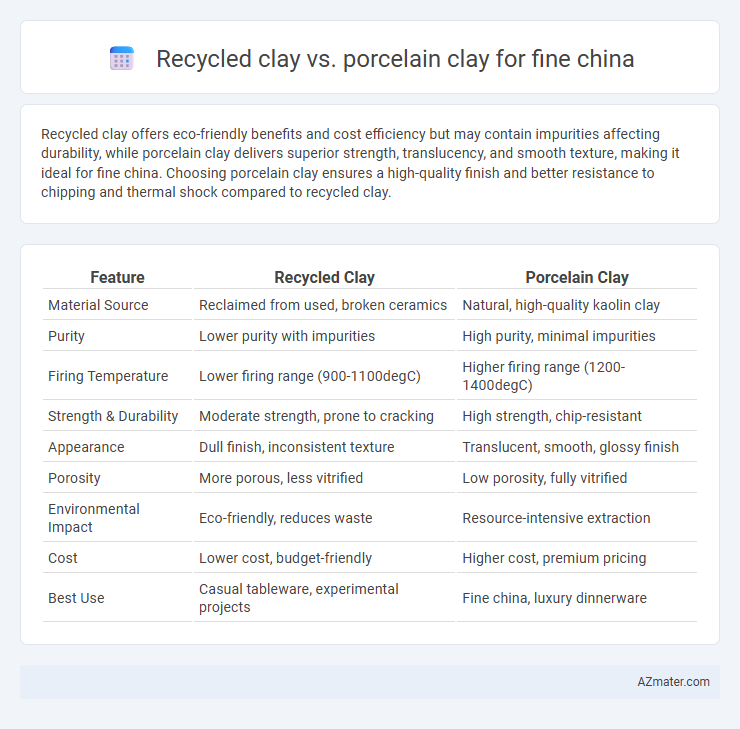Recycled clay offers eco-friendly benefits and cost efficiency but may contain impurities affecting durability, while porcelain clay delivers superior strength, translucency, and smooth texture, making it ideal for fine china. Choosing porcelain clay ensures a high-quality finish and better resistance to chipping and thermal shock compared to recycled clay.
Table of Comparison
| Feature | Recycled Clay | Porcelain Clay |
|---|---|---|
| Material Source | Reclaimed from used, broken ceramics | Natural, high-quality kaolin clay |
| Purity | Lower purity with impurities | High purity, minimal impurities |
| Firing Temperature | Lower firing range (900-1100degC) | Higher firing range (1200-1400degC) |
| Strength & Durability | Moderate strength, prone to cracking | High strength, chip-resistant |
| Appearance | Dull finish, inconsistent texture | Translucent, smooth, glossy finish |
| Porosity | More porous, less vitrified | Low porosity, fully vitrified |
| Environmental Impact | Eco-friendly, reduces waste | Resource-intensive extraction |
| Cost | Lower cost, budget-friendly | Higher cost, premium pricing |
| Best Use | Casual tableware, experimental projects | Fine china, luxury dinnerware |
Introduction to Fine China Materials
Fine china is primarily crafted from porcelain clay, prized for its purity, strength, and translucency, which create the delicate, high-quality finish characteristic of luxury dinnerware. Recycled clay, often blended with natural porcelain clay, offers an eco-friendly alternative but may slightly compromise the consistency and translucency critical to fine china standards. Understanding the differences in plasticity, firing temperature, and particle size between recycled clay and traditional porcelain clay is essential for optimizing material performance in fine china production.
Overview of Recycled Clay
Recycled clay for fine china involves reprocessing previously used clay materials to create a sustainable and cost-effective option, maintaining essential properties like plasticity and workability. This eco-friendly alternative reduces waste and conserves natural resources by reusing broken or excess porcelain fragments mixed with fresh clay. While recycled clay may have slight variations in texture and firing behavior compared to pure porcelain clay, it remains a viable choice for producing durable, high-quality fine china with lower environmental impact.
Overview of Porcelain Clay
Porcelain clay, composed of kaolin, feldspar, and quartz, offers exceptional whiteness, translucency, and strength essential for fine china production. Its fine particle size and plasticity allow intricate shaping and delicate detailing, resulting in elegant, durable dinnerware. Unlike recycled clay, porcelain clay undergoes high-temperature firing (1200-1400degC), enhancing vitrification and creating a non-porous, glass-like surface prized in luxury ceramics.
Key Differences: Recycled vs Porcelain Clay
Recycled clay contains impurities and variable particle sizes, resulting in less uniformity and lower strength compared to the highly refined, pure composition of porcelain clay. Porcelain clay offers superior translucency, durability, and a fine, smooth texture ideal for luxury fine china, whereas recycled clay is more prone to cracking and color inconsistencies. The firing temperature for porcelain clay is typically higher, around 1200-1400degC, ensuring vitrification and a non-porous finish, unlike recycled clay which may require lower temperatures and produce a less durable product.
Sustainability and Environmental Impact
Recycled clay significantly reduces the demand for virgin raw materials in fine china production, minimizing environmental degradation and landfill waste. Porcelain clay, though prized for its strength and translucency, often requires high-energy firing processes that contribute to a larger carbon footprint. Choosing recycled clay supports sustainability by promoting circular resource use and lowering greenhouse gas emissions associated with traditional porcelain manufacturing.
Physical Properties and Workability
Recycled clay for fine china typically exhibits a coarser texture and lower plasticity compared to porcelain clay, affecting its workability and detail precision. Porcelain clay offers a smoother, more refined consistency with excellent plasticity, enabling intricate shaping and finer detailing in delicate ceramics. Its higher vitrification temperature also results in superior strength and translucency, key physical properties preferred in fine china production.
Aesthetic Qualities and Finish
Recycled clay offers a rustic texture and variable coloration that appeals to eco-conscious fine china makers, while porcelain clay provides a smooth, translucent finish prized for its elegance and refined detail. Porcelain's high kaolin content ensures a bright white surface and a glass-like vitrification, enhancing the aesthetic appeal through subtle translucency and uniformity. Recycled clay may yield a more organic, less uniform finish, which can add character but lacks the pristine, glossy sheen that porcelain delivers in fine china production.
Durability and Longevity
Porcelain clay offers superior durability and longevity compared to recycled clay, making it the preferred choice for fine china that requires resistance to chipping and cracking. The high kaolin content in porcelain clay contributes to its dense, vitrified structure, enhancing strength and moisture resistance over time. Recycled clay may contain impurities and a less uniform composition, potentially reducing the fine china's lifespan and structural integrity under frequent use.
Cost Comparison and Accessibility
Recycled clay offers a cost-effective alternative to porcelain clay in fine china production due to lower raw material and processing expenses. Porcelain clay, made from high-quality kaolin, tends to be more expensive but provides superior translucency and strength, which justifies its higher price in premium markets. Accessibility of recycled clay is increasing as sustainability practices grow in the ceramics industry, while porcelain clay remains limited to specific suppliers specializing in fine china materials.
Choosing the Right Clay for Fine China
Recycled clay offers an eco-friendly option with a slightly coarser texture and reduced plasticity, which may affect the delicate finish required for fine china. Porcelain clay, known for its high purity, translucency, and smooth texture, remains the preferred choice for producing elegant and durable fine china pieces. Selecting the right clay depends on the balance between environmental considerations and the desired aesthetic and functional qualities of the finished product.

Infographic: Recycled clay vs Porcelain clay for Fine china
 azmater.com
azmater.com